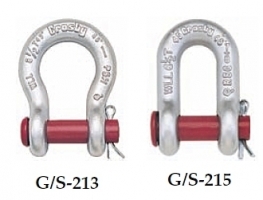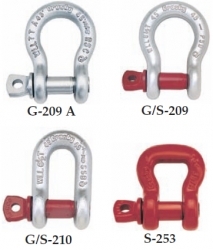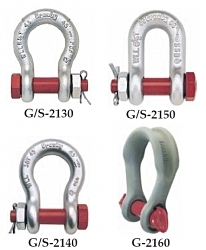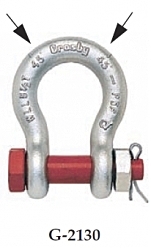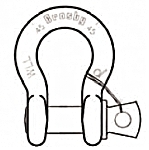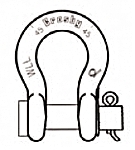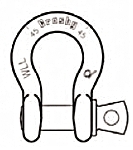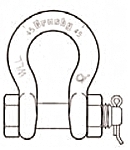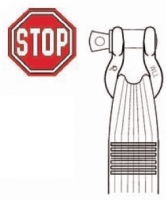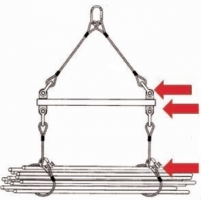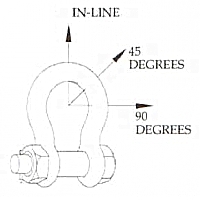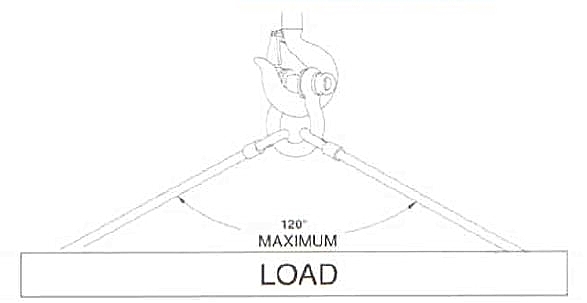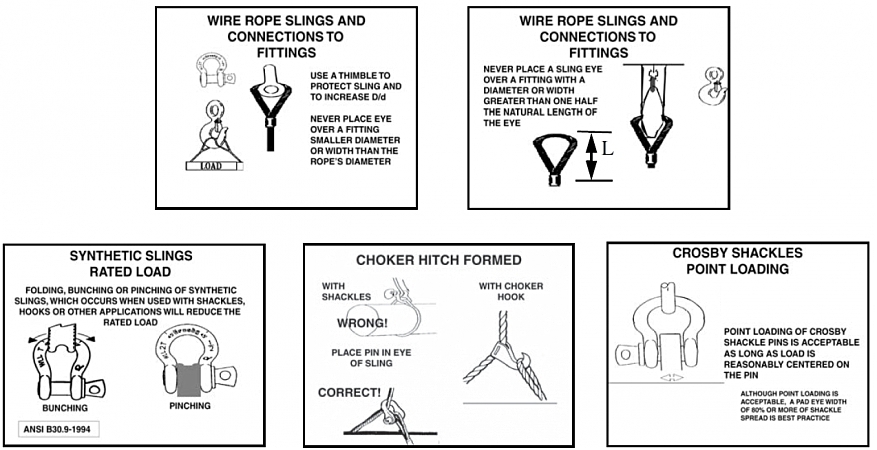Shackles
APPLICATION INFORMATION
|
Round Pin Shackles can be used in tic down, towing, suspension or lifting applications where the load is strictly applied in-line. Round pin shackles should never be used in rigging applications to gather multiple sling legs, or where side loading conditions may occur. |
Screw Pin Shackles are used in Pick and Place* applications. For permanent or long-term installations, Crosby recommends the use of bolt type shackles. If you choose to disregard Crosby's recommendation, the screw pin shall be secured from rotation or loosening (Page 73).
Screw pin shackles can be used for applications involving side-loading circumstances. Reduced working load limits are required for side-loading applications. While in service, do not allow the screw pin to be rotated by a live line, such as a choker application.
* Pick and Place application: Pick (move) a load and place as required Tighten screw pin before each pick. |
|
|
Bolt-Type Shackles can be used in any application where round pin or screw pin shackles are used. In addition, they are recommended for permanent or long term installations and where the load may slide on the shackle pin causing the pin to rotate. The bolt-type shackle's secondary securement system, utilizing a nut and cotter, eliminates the requirement to tighten pin before each lift or movement of load. |
| QUIC-CHECK® INFORMATION |
|
|
All Crosby Shackles, with the exception of 2160.252 and 253 styles, incorporate markings forged into the product that address an easy to use QUIC-CHECK4- feature. Angle indicators are forged into the shackle bow at 45 degree* angles from vertical. These are utilized on screw pin and bolt type shackles to quickly check the approximate angle of a two-legged hitch, or quickly check the angle of a single leg hitch when the shackle pin is secured and the pull of the load is off vertical (side loaded), thus requiring a reduction in the working load limit of the shackle.
* Round Pin Shackles utilize the 45 degree QUIC-CHECK® indicators to ensure load is applied strictly in-line. |
SCREW PIN SHACKLES PIN SECURITY |
SHACKLES |
MOUSE SCREW PIN WHEN USED IN LONG TERM OR HIGH VIBRATION APPICATIONS
Mouse or Mouseing (screw pin shackle) is a secondary securemeni method used to secure screw pin from rotation or loosening. Annealed iron wire is looped through hole in collar of pin and around adjacent leg of shackle body with wire ends securely twisted together. Multiple wraps are required for securement where the load may slide on the shackle pin. |
|
|
|
| ROUND PIN |
SCREW PIN |
BOLT-TYPE |
Do not side load, do not use as a collector nng, always use cotter pin. |
Use when picking and placing a load, tighten pin proior to each lift |
Use in permanent or long-term installation alway use nut and cotter. |
|
CONNECTION OF SLINGS TO SHACKLES |
BOLT-TYPE SHACKLE |
| Diameter of shackle must be greater than wire ropediameter if no thimble in eye. |
|
Shackle must be large enough to avoid pinching of synthetic slings. |
|
|
| |
|
|
Use Bolt-Type
Shackle when a permanent or long term connection
Use a screw pin shackles ~ when it will be a temporary connection. |
|
RIGGING PRACTICE SHACKLES
• Screw pin shall be fully engaged
• If designed for a cotter pin, it shall be used and maintained
• Applied load should be centered in the bow to prevent side loading
• Multiple sling legs should not be applied to the pin
• If side loaded, the rated load shall be reduced according to Table 1, on page 74
| For 3/16"-3" Shackles |
| Angle loads must be IN-LINE applied in the plane . 01 I hi- bow. |
|
Table 1 |
Side Loading Reduction Chart For Screw Pin and Bolt Typa Shackfau Only + |
Angle of Side Lewd front Vortical In-Line of Shackle |
Adjustad Working Load Limit |
0 In-Line* |
100% Rated Working Load Limit |
45 from In-Line* |
70% of Rated Working Load Limit |
90 from In-Line* |
50% of Rated Working Load Limit |
* In-Line load iv lipplicd perpendicular in pin
+ DO NOT SIDE LOAD ROUND PIN |
| Never Exceed 120° included angle. Use Bolt Type and Screw Pin Shackles ONLY. |
|
Shackles symmetrically loaded with two leg slings having a maximum included angle of 120° can be u ti lized to full Working Load Limit. |
|





